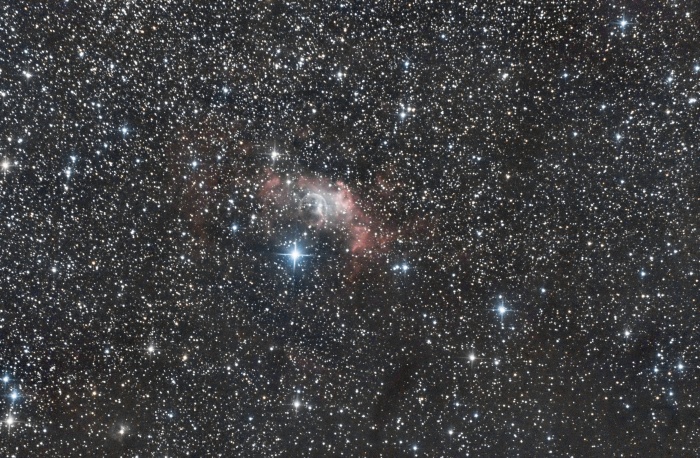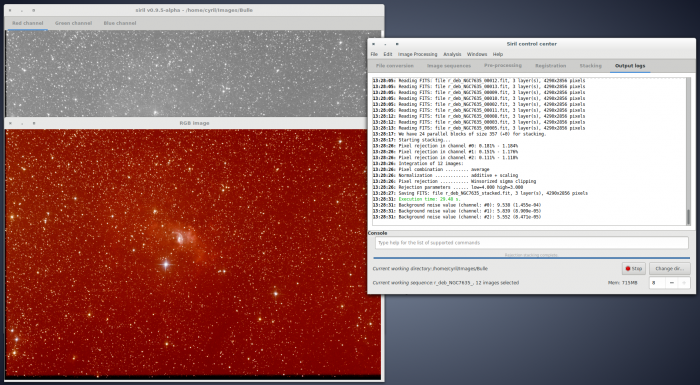No edit summary |
No edit summary |
||
| Line 53: | Line 53: | ||
</code> | </code> | ||
Noise estimation is a good estimator of the quality of your stacking process. In our example, the red channel has almost 1.5 times more noises that green or blue. That probably means that DSLR is unmodified: most of red photon are stopped by the original filter, therefore leading to a more noisy channel. Then, in this example we note that high rejection seems to be a bit strong. Setting high rejection to <math>\sigma_{high}=4</math> could produce a better image. And this is what | Noise estimation is a good estimator of the quality of your stacking process. In our example, the red channel has almost 1.5 times more noises that green or blue. That probably means that DSLR is unmodified: most of red photon are stopped by the original filter, therefore leading to a more noisy channel. Then, in this example we note that high rejection seems to be a bit strong. Setting high rejection to <math>\sigma_{high}=4</math> could produce a better image. And this is what we have in the image below. | ||
<!--T:9--> | <!--T:9--> | ||
Revision as of 22:05, 14 February 2015
Siril processing tutorial
- Convert your images in the FITS format Siril uses (image import)
- Work on a sequence of converted images
- Pre-processing images
- Registration (PSF image alignment)
- → Stacking
Stacking
The final step to do with Siril is to stack the images. Go to the "stacking" tab, indicate if you want to stack all images, only selected images or the best images regarding the value of FWHM previously computed. Siril proposes several algorithms for stacking computation.
- Sum Stacking
This is the simplest algorithm: each pixel in the stack is summed using 32-bit precision, and the result is normalized to 16-bit. The increase in signal-to-noise ratio (SNR) is proportional to [math]\displaystyle{ \sqrt{N} }[/math], where [math]\displaystyle{ N }[/math] is the number of images.
- Average Stacking With Rejection
- Percentile Clipping: this is a one step rejection algorithm ideal for small sets of data (up to 6 images).
- Sigma Clipping: this is an iterative algorithm which will reject pixels whose distance from median will be farthest than two given values in sigma units ([math]\displaystyle{ \sigma_{low} }[/math], [math]\displaystyle{ \sigma_{high} }[/math]).
- Median Sigma Clipping: this is the same algorithm except than the rejected pixels are replaced by the median value of the stack.
- Winsorized Sigma Clipping: this is very similar to Sigma Clipping method but it uses an algorithm based on Huber's work [1] [2].
- Linear Fit Clipping: this is an algorithm developed by Juan Conejero, main developer of PixInsight [2]. It fits the best straight line ([math]\displaystyle{ y=ax+b }[/math]) of the pixel stack and rejects outliers. This algorithm performs very well with large stacks and images containing sky gradients with differing spatial distributions and orientations.
These algorithms are very efficient to remove satellite/plane tracks.
- Median Stacking
This method is mostly used for dark/flat/offset stacking. The median value of the pixels in the stack is computed for each pixel. As this method should only be used for dark/flat/offset stacking, it does not take into account shifts computed during registration. The increase in SNR is proportional to [math]\displaystyle{ 0.8\sqrt{N} }[/math].
- Pixel Maximum Stacking
This algorithm is mainly used to construct long exposure star-trails images. Pixels of the image are replaced by pixels at the same coordinates if intensity is greater.
In the case of M8-M20 sequence, we first used the "Winsorized Sigma Clipping" algorithm in "Average stacking with rejection" section, in order to remove satellite tracks ([math]\displaystyle{ \sigma_{low}=4 }[/math] and [math]\displaystyle{ \sigma_{high}=2 }[/math]).
The output console thus gives the following result:
21:58:19: Pixel rejection in channel #0: 2.694% - 4.295%
21:58:19: Pixel rejection in channel #1: 1.987% - 3.620%
21:58:19: Pixel rejection in channel #2: 0.484% - 4.297%
21:58:19: Rejection stacking complete. 119 have been stacked.
21:58:28: Noise estimation (channel: #0): 4.913e-05
21:58:28: Noise estimation (channel: #1): 3.339e-05
21:58:28: Noise estimation (channel: #2): 3.096e-05
Noise estimation is a good estimator of the quality of your stacking process. In our example, the red channel has almost 1.5 times more noises that green or blue. That probably means that DSLR is unmodified: most of red photon are stopped by the original filter, therefore leading to a more noisy channel. Then, in this example we note that high rejection seems to be a bit strong. Setting high rejection to [math]\displaystyle{ \sigma_{high}=4 }[/math] could produce a better image. And this is what we have in the image below.
After that, the result is saved in the file named below the buttons, and is displayed in the grey and colour windows. You can adjust levels if you want to see it better, or use the different display mode. In our example the file is the stack result of all files, i.e., 119 files.
The images above picture the result in Siril using the Histogram Equalization rendering mode. Note the improvement of the signal-to-noise ratio regarding the result given for one frame in the previous step (take a look to the sigma value). The increase in SNR is of [math]\displaystyle{ 38/3.9 = 9.7 \approx \sqrt{119} = 10.9 }[/math] and you should try to improve this result adjusting [math]\displaystyle{ \sigma_{low} }[/math] and [math]\displaystyle{ \sigma_{high} }[/math].
Here, comparison between the same crop of calibrated single frame and stacked result.
Now should start the process of the image with crop, background extraction (to remove gradient), and some other processes to enhance your image. To see processes available in Siril please visit this page.
Here an example of what you can get with Siril:

End of the processing tutorial. Return to the main documentation page for more illustrated tutorials.




